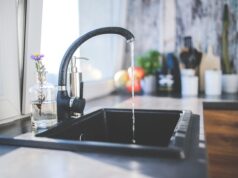Contents
Designing an Efficient and Stylish Kitchen Sink Plumbing System: Here’s How
When it comes to designing a kitchen, one of the most crucial aspects to consider is the plumbing system for the sink. An efficient and stylish kitchen sink plumbing system not only adds functionality and convenience but also enhances the overall aesthetics of the space. In this article, we will discuss some key factors to keep in mind when designing your kitchen sink plumbing system.
1. Layout and Placement: Start by considering the layout and placement of your kitchen sink. Ensure that it is located in a convenient spot, allowing easy access to water supply and drainage pipes. Consider factors such as proximity to windows, walls, and countertops to optimize the flow and functionality of your plumbing system.
2. Adequate Ventilation: Proper ventilation is essential for an efficient kitchen sink plumbing system. Install a vent stack or an air admittance valve (AAV) to prevent sewer gases from entering your kitchen and to ensure smooth drainage without any unpleasant odors.
3. Choosing the Right Materials: Select high-quality materials for your plumbing system to ensure durability and longevity. Opt for corrosion-resistant pipes such as copper or PVC to prevent leaks and blockages. Additionally, consider using stylish fixtures and faucets that complement your kitchen’s design.
4. Effective Drainage System: A well-designed drainage system is crucial to prevent clogs and backups. Install a properly sized trap and a well-placed cleanout for easy access and maintenance. Consider using slope pipes to promote efficient drainage and minimize the risk of blockages.
5. Efficient Water Supply: To ensure a steady and reliable water supply, install high-quality shut-off valves and consider incorporating energy-efficient features such as low-flow faucets and aerators. This not only helps reduce water wastage but also contributes to a sustainable and eco-friendly kitchen.
In conclusion, designing an efficient and stylish kitchen sink plumbing system requires careful consideration of layout, materials, drainage, ventilation, and water supply. By keeping these factors in mind, you can create a functional and visually pleasing kitchen that meets your needs and enhances your cooking experience.
Designing an Efficient and Stylish Kitchen Sink Plumbing System: Here’s How
The Importance of a Well-Designed Kitchen Sink Plumbing System
The plumbing system of a kitchen sink plays a vital role in both functionality and the overall aesthetics of the kitchen. A well-designed plumbing system not only ensures efficient water flow and drainage but also adds a touch of style to your kitchen. In this article, we will explore the key elements and considerations for designing an efficient and stylish kitchen sink plumbing system.
The Elements of an Efficient Kitchen Sink Plumbing System
A well-designed kitchen sink plumbing system consists of various components that work together to provide a seamless experience. Here are the key elements to consider:
- Faucet: Choose a high-quality faucet that complements the style of your kitchen. Make sure it has features like a swivel spout and a pull-down spray nozzle for added convenience.
- Sink: Select a sink that suits your needs and adds to the overall aesthetics of your kitchen. Stainless steel sinks are popular due to their durability and easy maintenance.
- Drainage: Ensure proper drainage by installing a well-designed trap and waste pipe under the sink. The trap prevents foul odors from entering your kitchen, while the waste pipe efficiently carries away wastewater.
- Hot and Cold Water Supply: Connect your kitchen sink to the hot and cold water supply lines with high-quality pipes and fittings. Consider using energy-efficient options like insulated pipes to minimize heat loss.
- Garbage Disposal: If you plan on having a garbage disposal unit, make sure to include it in your plumbing system design. Ensure that it is properly connected to the sink and has a dedicated electrical circuit to prevent overloads.
Choosing the Right Materials
When designing your kitchen sink plumbing system, it is essential to choose high-quality materials that will withstand daily use and provide long-lasting performance. Here are some materials to consider:
- Pipes: Opt for copper or CPVC (chlorinated polyvinyl chloride) pipes for water supply lines, as they are durable and resistant to corrosion. For waste pipes, PVC (polyvinyl chloride) or ABS (acrylonitrile butadiene styrene) pipes are commonly used.
- Fittings: Choose fittings made from materials such as brass or stainless steel for better durability and leak-free connections.
- Traps: Select traps made of PVC or ABS for efficient drainage and odor prevention.
Maintaining an Efficient and Stylish Kitchen Sink Plumbing System
Once your kitchen sink plumbing system is installed, proper maintenance is crucial to ensure its efficiency and longevity. Here are some maintenance tips to keep in mind:
- Regular Cleaning: Clean your sink, faucet, and drain regularly to prevent buildup of debris and maintain a hygienic kitchen environment.
- Plumbing Inspections: Schedule periodic inspections by a professional plumber to identify any potential issues early on and prevent major plumbing problems.
- Addressing Leaks Promptly: If you notice any leaks, no matter how small, address them immediately to prevent water damage and mold growth.
Conclusion
Designing an efficient and stylish kitchen sink plumbing system requires careful consideration of various elements such as faucet selection, sink choice, drainage design, and materials used. By paying attention to these factors and ensuring proper maintenance, you can create a plumbing system that not only functions flawlessly but also adds a touch of elegance to your kitchen.
For more information on kitchen sink plumbing system design, you can visit ExampleWebsite.com.
Frequently Asked Questions:
1. What is an efficient and stylish kitchen sink plumbing system?
An efficient and stylish kitchen sink plumbing system refers to the design and layout of pipes, fixtures, and components that ensure smooth water flow, effective drainage, and an aesthetically pleasing appearance in your kitchen sink area.
2. How can I improve the efficiency of my kitchen sink plumbing system?
To enhance the efficiency of your kitchen sink plumbing system, you can:
- Install high-quality faucets and fixtures that provide optimal water pressure and minimize leaks.
- Use durable pipes made of materials like copper or stainless steel to prevent frequent repairs and leaks.
- Ensure proper ventilation to prevent clogs and foul odors.
- Regularly inspect and maintain your plumbing system to detect and fix any issues promptly.
3. How can I make my kitchen sink plumbing system stylish?
To make your kitchen sink plumbing system stylish, you can:
- Choose modern and visually appealing faucet designs that match your kitchen’s overall aesthetic.
- Opt for undermount sinks that provide a sleek and seamless look, or farmhouse sinks for a rustic touch.
- Consider incorporating decorative elements such as colored or patterned pipes, faucet handles, or soap dispensers.
- Coordinate the colors and finishes of your plumbing fixtures with your kitchen décor for a cohesive look.
4. Are there any eco-friendly options for a kitchen sink plumbing system?
Yes, there are eco-friendly options available for a kitchen sink plumbing system. Some options include:
- Installing low-flow faucets and aerators to reduce water consumption.
- Using water-saving dishwashers and garbage disposals.
- Implementing a greywater recycling system to reuse water for non-potable purposes.
- Insulating hot water pipes to minimize heat loss and waste.
5. Can I design my own kitchen sink plumbing system or should I hire a professional?
Designing a kitchen sink plumbing system requires knowledge of plumbing codes, pipe sizing, and layout considerations. While it is possible to design your own system, it is generally recommended to hire a professional plumber or kitchen designer who can ensure proper functionality and compliance with regulations.
Understanding Kitchen Sink Plumbing
When it comes to kitchen sink plumbing, it’s important to ensure that everything is properly installed and functioning correctly. Here are some key aspects to consider:
1. Drainage System
The drainage system is an essential component of kitchen sink plumbing. It should consist of a drainpipe and a trap. The drainpipe connects the sink to the main sewage line, while the trap prevents unpleasant sewer gases from entering your kitchen.
2. Water Supply Lines
The water supply lines transport clean water to your kitchen sink. These should be made of durable materials, such as copper or PVC, to avoid leaks and ensure a steady flow of water. Make sure the supply lines are securely connected to the faucet and shut-off valves.
3. Ventilation
Proper ventilation is crucial for effective drainage. It prevents airlock, which can lead to slow drainage or gurgling sounds when water flows down the sink. Vent pipes connect to the drainage system and extend upwards, allowing air to enter and equalize the pressure.
4. Adequate Space
A well-designed kitchen sink plumbing system should consider the available space. All pipes and fittings should be installed in a way that maximizes storage and workspace around the sink. This includes carefully planning the placement of garbage disposals, dishwashers, and other appliances connected to the sink.
It’s important to note that while this article provides a general overview, it’s always best to consult a professional plumber for specific advice tailored to your kitchen sink plumbing needs.
For further information on kitchen sink plumbing components and their installation, you can visit the Wikipedia page on Drain-waste-vent system.
Designing an Efficient and Stylish Kitchen Sink Plumbing System: Here’s How
Benefits of an Efficient Kitchen Sink Plumbing System
- Maximizes water usage and reduces wastage
- Minimizes the risk of clogs and backups
- Improves overall functionality and convenience
- Enhances the aesthetic appeal of the kitchen
Considerations for Designing an Efficient System
- Optimize the layout to minimize pipe length and create a smooth flow
- Choose high-quality plumbing fixtures and materials
- Install a garbage disposal unit for easy waste management
- Incorporate water-saving features, such as aerators and low-flow faucets
- Properly size and position the drain pipe for efficient drainage
Trends in Stylish Kitchen Sink Plumbing
- Contemporary and minimalist designs
- Metallic finishes for faucets and handles
- Undermount sinks for a sleek and seamless look
- Multifunctional faucets with additional features, like pull-out sprayers






























